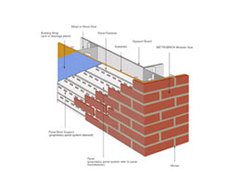Are you looking to learn more about thin brick veneer details, thin brick precast concrete panels, and their applications? This comprehensive guide will provide you with valuable insights into the world of thin brick veneer, from its characteristics and advantages to practical tips for installation and maintenance. Whether you’re a homeowner embarking on a renovation project or a professional in the construction industry, understanding the intricacies of thin brick veneer and precast concrete panels can empower you to make informed decisions and achieve stunning results in your architectural endeavors.
Thin brick veneer, also known as brick tiles or brick cladding, is a lightweight alternative to full-size bricks. Ranging from 0.5 to 1 inch in thickness, it is designed to mimic the appearance of traditional brick. Made from natural clay or concrete, thin brick veneer offers the authentic charm and texture of brick while providing versatility in applications. Its advantages lie in its numerous benefits, such as being significantly lighter than standard bricks, available in a wide array of colors, textures, and finishes, and easy to install, making it an attractive option for various construction and renovation projects.
Advantages of Thin Brick Veneer Details
Thin brick veneer is significantly lighter than standard bricks, making it suitable for both interior and exterior use without requiring additional structural support. Furthermore, it is available in a wide array of colors, textures, and finishes, allowing for endless design possibilities. Its ease of installation and cost-effectiveness make it an attractive option for various construction and renovation projects.
| Pros | Cons |
| Lightweight | Limited load-bearing capability |
| Versatile in design and application | May require sealing for enhanced durability |
| Cost-effective | Limited insulating properties |
Applications of Thin Brick Veneer
Thin brick veneer and precast concrete walls can be utilized in diverse applications, including accent walls, fireplaces, backsplashes, and façades. Its ability to adhere to various surfaces expands its potential uses, enabling the creation of striking architectural features and adding character to both residential and commercial spaces.
Choosing the Right Thin Brick Veneer for Your Project
When selecting thin brick veneer for your project, several factors should be taken into account. These include the desired aesthetic, color palette, texture, and the overall style of the intended space. Additionally, assessing the product’s durability, weather resistance, and fire rating is crucial, particularly for exterior applications. In some cases, precast concrete panels may be a viable alternative to traditional thin brick veneer. These panels offer the aesthetic appeal of brick while providing the structural benefits of concrete. Understanding the distinctions between thin brick veneer and precast concrete panels is essential for determining the most suitable option for your specific project requirements.
Installation Tips and Techniques for Thin Brick Veneer
Proper surface preparation is paramount for the successful installation of thin brick veneer. The substrate must be clean, structurally sound, and free from any contaminants that could hinder adhesion. Depending on the substrate material, specific preparation methods may be required to ensure optimal bonding. Selecting the appropriate adhesive or mortar is a critical aspect of thin brick veneer installation. The chosen adhesive should be compatible with both the veneer and substrate while offering the necessary strength and flexibility to accommodate potential movement and environmental factors. After the thin brick veneer is installed, grouting and sealing play a vital role in enhancing the overall appearance and longevity of the surface. Proper grout selection and application techniques, along with the use of quality sealants, contribute to the durability and maintenance of the veneer.
Maintaining and Caring for Thin Brick Veneer Surfaces
Maintaining the aesthetics and structural integrity of thin brick veneer involves implementing routine maintenance practices. This may include regular cleaning to remove dirt, dust, and other contaminants that accumulate over time, thereby preserving the veneer’s visual appeal. In the event of damage or wear, prompt attention and appropriate repairs are essential to prevent further deterioration. Understanding the recommended repair methods and materials for thin brick veneer enables property owners to address issues effectively and sustain the veneer’s condition.
Creative Design Ideas Using Thin Brick Veneer
In interior spaces, thin brick veneer can be used to create captivating feature walls, accentuating focal points such as fireplaces, kitchen backsplashes, and entryways. Its ability to infuse warmth and texture into the environment makes it a versatile element in diverse design styles, from industrial to rustic and contemporary. For exterior applications, thin brick veneer can elevate the curb appeal of residential properties, enhance commercial facades, and revitalize outdoor living areas. It can be employed to clad entire exteriors or to highlight architectural details, imparting a timeless aesthetic to modern structures.
Real-Life Success Stories: Thin Brick Veneer Transformations
In residential renovations, thin brick veneer has been instrumental in reviving outdated interiors and exteriors. Homeowners have achieved remarkable transformations by incorporating thin brick veneer, breathing new life into spaces and achieving a rich, textured look reminiscent of traditional brickwork. Within commercial settings, thin brick veneer has been embraced for its ability to convey a sense of heritage and sophistication. From retail establishments to hospitality venues, the integration of thin brick veneer has contributed to the creation of inviting and distinctive environments, leaving a lasting impression on visitors and patrons.
In conclusion, thin brick veneer offers a wealth of design possibilities, structural benefits, and aesthetic appeal, making it a sought-after material in the realm of architecture and interior design. By understanding the intricacies of thin brick veneer, from selection to installation and maintenance, individuals and professionals alike can harness its potential to elevate spaces and achieve enduring beauty. Whether used in residential renovations or commercial constructions, the enduring allure of thin brick veneer continues to inspire captivating design ventures and transformative architectural endeavors. By incorporating the insights provided in this guide, you are well-equipped to embark on your own thin brick veneer journey, unlocking the secrets to success and realizing the full potential of this versatile building material.
For additional info about Ohio companies, use Unframed World!

